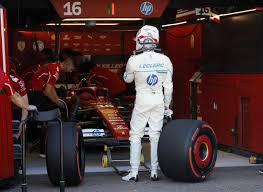Leclerc Dominates Friday Practice Sessions: A Look at His Speed and Strategy
SPORT
5/23/20257 min read


Introduction
As the Formula 1 circuit continues to captivate a global audience, the Friday practice sessions serve as a crucial indicator of team performance and driver readiness leading into the race weekend. Recently, these sessions blossomed into a showcase of skill and strategy, particularly for Charles Leclerc, whose impressive speed drew significant attention from fans and analysts alike. In the world of motorsport, practice sessions are not merely preliminary; they are a vital component of race preparation, allowing teams to fine-tune their vehicles and drivers to familiarize themselves with the track conditions. Leclerc's distinguished performance during these sessions exemplified both his driving prowess and an astute understanding of his team's strategy.
During the last event, Leclerc's ability to maintain a competitive edge was evident as he consistently clocked fast lap times while navigating a challenging circuit. His execution not only highlighted his personal skill but also underscored the collaborative efforts of the Scuderia Ferrari team. The synergy between driver and team is paramount; each component, from tire selection to aerodynamic adjustments, plays a role in the outcome of not just practice, but the subsequent races as well. Additionally, Leclerc's approach to these sessions provides insights into his mindset as he gears up for competition.
The significance of Friday practice cannot be overstated, as it not only sets the tone for the weekend but also builds momentum for what is expected to be an intense race. As we delve deeper into analysis, it will be essential to dissect Leclerc's strategies and execution during these initial practice runs, looking at how they position him favorably as the race approaches.
Leclerc's Performance Overview
During the recent Friday practice sessions, Charles Leclerc showcased remarkable speed and precision, establishing himself as a formidable contender. Throughout both sessions, Leclerc consistently recorded the fastest lap times, demonstrating his ability to extract maximum performance from his car. In the first session, he completed 32 laps, with his best time clocked at a commendable 1:30.115. This lap not only set the benchmark for the day but also placed him ahead of significant competitors, including reigning champion Lewis Hamilton and rival Max Verstappen, who struggled to match Leclerc's pace.
The second practice saw Leclerc continue his dominance, further improving his time to 1:29.845 after completing another 30 laps. His adeptness in navigating the circuit’s nuances was evident, allowing him to optimize his racing line and braking points effectively. This agility translated into increased confidence, enabling him to push the limits while ensuring tire management remained a priority. In contrast, drivers such as Sergio Pérez and Lando Norris faced challenges, with their times hovering around 1:31, highlighting the competitive advantage Leclerc sustained throughout the sessions.
Leclerc’s performance was not merely a function of raw speed; it was also a testament to a well-executed strategy. His team ensured that he had adequate tires and optimal setup adjustments, allowing for continuous improvements as the sessions progressed. By rigorously analyzing his data, Leclerc was able to refine his approach, adapting to track conditions and enhancing his vehicle’s performance. As the practice sessions concluded, it became clear that Leclerc's meticulous attention to detail and strategic foresight positioned him as a leading figure heading into the weekend's race.
Technical Insights: Car Setup and Changes
Charles Leclerc's performance during the Friday practice sessions can largely be attributed to meticulous car setup and strategic adjustments made by the Scuderia Ferrari team. In preparation for the race weekend, the team focused on fine-tuning the car to the specific demands of the circuit. This included alterations in aerodynamics, suspension settings, and tire choices, all aimed at enhancing overall speed and handling.
One of the primary adjustments involved reconfiguring the aerodynamic balance of the car. By optimizing the front and rear wing settings, the Ferrari engineers significantly improved the downforce, allowing Leclerc to maintain higher cornering speeds without sacrificing stability. Close attention was also paid to the ride height and suspension stiffness, which were tailored to accommodate the unique characteristics of the track. These changes collectively contributed to boosting the car's grip and responsiveness, critical for achieving quick lap times.
Additionally, tire management strategies were a focal point during practice. The team experimented with different tire compounds to assess their performance and durability under various conditions. Leclerc’s feedback was instrumental, guiding the team in determining the most suitable tires for the specific track layout. Striking the right balance between performance and tire degradation was crucial for the Ferrari strategy, especially when planning for qualifying and the race.
Furthermore, data analysis played a central role in refining the car’s setup. Utilizing telemetry systems, the engineers monitored Leclerc's driving patterns and the car's performance metrics in real-time. This information allowed for dynamic adjustments to be made throughout the sessions, ensuring that the car remained competitive against rival teams. Overall, the technical insights into Leclerc's car setup highlight the significant role that engineering and strategy play in optimizing performance on race day.
Competitors' Response
The recent Friday practice sessions showcased Charles Leclerc’s exceptional speed on the track, prompting significant reactions from his competitors. As teams gathered insights on Leclerc’s impressive performance, they also had to evaluate their strategies and adapt accordingly. Notably, drivers such as Lewis Hamilton, Max Verstappen, and Sergio Perez responded with an intensified focus on optimizing their vehicle performance to keep pace with Leclerc’s remarkable lap times.
During the sessions, Hamilton appeared determined to close the gap, attempting various setups and tire strategies in hopes of understanding the nuances of Leclerc's speed. The Mercedes team analyzed data meticulously, considering adjustments to balance and aerodynamics to enhance their competitiveness. Hamilton’s observations suggested a particular interest in Leclerc's cornering techniques, which could be pivotal for gaining seconds on the track.
In contrast, Verstappen, who often thrives under competitive pressure, exhibited a more aggressive approach during practice. Recognizing Leclerc’s superior pace, he and his Red Bull Racing team dove into race simulations, refining their strategy to include potential tire wear and fuel load considerations. This proactive stance aimed to improve their overall performance in the upcoming sessions and race, ensuring they could challenge Leclerc effectively.
Sergio Perez also joined the tactical dialogue, reflecting on the necessity of collaboration within the team to learn from Leclerc's strengths. By analyzing telemetry data, he focused on identifying specific sectors where improvements could be made, displaying a keen awareness of the need for cohesive teamwork in closing the performance gap. This adaptability across various teams underscores the highly competitive nature of this season and the increasingly precise strategies being employed.
The Impact of Weather Conditions
The Friday practice sessions of the recent Formula One race showcased the significant influence of weather conditions on team strategies, particularly for Charles Leclerc and Scuderia Ferrari. Amidst the ever-changing climate, varying temperatures and track conditions played a crucial role in shaping tire choices and overall performance. Weather, often a variable component in racing, can affect not only grip levels but also the durability of tires.
On the particular day of the practice sessions, teams contended with fluctuating temperatures that ranged noticeably throughout the day. This variability in temperature influenced the track surface, impacting how tires performed under these conditions. For Leclerc, who has shown formidable speed in previous races, adapting to the temperature fluctuations was essential to maximizing his performance potential. Ferrari's engineering team closely monitored these conditions, as the balance between tire temperature and degradation is vital for optimizing lap times.
In addition, there were instances where track conditions changed due to sporadic weather patterns, which could lead to a temporary decline in grip. Recognizing these factors, Leclerc and his team were required to continuously assess their tire choices. The utilization of soft compounds, for instance, was pivotal during the sessions as drivers strived for the best out of their machines in the potential window of peak performance. Conversely, the harder compounds showcased their durability under warmer conditions, though at the expense of outright speed.
The interplay between tire selection and weather conditions provides an interesting dynamic. As drivers like Leclerc fine-tuned their strategies in relation to the unpredictable weather, it became evident that a firm grasp of environmental conditions could yield advantages on the track. This aspect of racing requires not only foresight but also adaptability, ultimately shaping the outcomes of practice and subsequent qualifications.
Leclerc's Strategy for the Race Weekend
During the recent Friday practice sessions, Charles Leclerc showcased impressive speed and consistency, indicating a strong foundation for his race weekend strategy. The performance not only highlighted his prowess on the track but also provided critical insights into his team's tactical approach for the upcoming race. Key factors contributing to Leclerc's strategic framework include tire selection, pit stop timing, and overall race management.
Team engineers have suggested that Leclerc's adept handling of the car during practice may translate into targeted tire strategies. The data collected during the sessions points towards a preference for soft tires in the early stages of the race. This choice could enable him to maintain a competitive edge during the initial laps, where acceleration and grip are paramount. Should track conditions evolve or their performance wane, he might opt for a medium tire strategy later in the race, allowing for greater durability amidst tire degradation.
Additionally, pit strategies will play a crucial role in determining Leclerc’s success. Insights from his team indicate a flexible approach to pit stops based on race dynamics, including competitor performance and tire wear rates. An early pit stop could be advantageous if he seeks to undercut rivals who remain on track longer. Conversely, delaying the pit stop might allow him to capitalize on potential incidents or caution periods, maximizing points in a congested field.
Ultimately, Leclerc's practice performance offers an intriguing glimpse into the preparations for the race. It underscores the importance of adaptability within his strategy, as unforeseen circumstances can often alter the course of race weekend. As race day approaches, his ability to execute the outlined strategies effectively will be pivotal in enhancing his chances of victory.
Conclusion and Future Expectations
Charles Leclerc's impressive performance during the Friday practice sessions has set a promising tone heading into the race weekend. His undeniable speed demonstrated in the sessions not only emphasizes his capability as a front-runner but also reassures his team about their competitive edge. Leclerc's adeptness in navigating the circuit and fine-tuning his vehicle showcases the synergy between driver and machine, which is essential for achieving podium finishes. His ability to consistently achieve fast lap times indicates that he is not just a contender but a serious threat against his rivals.
Looking ahead, expectations are high for Leclerc as he transitions from practice to the race. While his speed is commendable, potential challenges lie ahead that could impact his performance. The unpredictability of tire degradation, weather conditions, and strategic decisions during pit stops will play crucial roles in determining the outcome of the race. Moreover, the competition remains fierce, with several skilled drivers eager to challenge Leclerc's dominance. How well he adapts his strategy in response to these factors could well dictate whether he can convert practice success into race victory.
Additionally, team dynamics will be crucial, as Ferrari continuously strives to optimize their performance amidst evolving race conditions. Observing how Leclerc and the engineering team execute their strategies will be pivotal. If they can maintain consistency and adapt to unforeseen circumstances, Leclerc stands a strong chance of securing a remarkable finish. Ultimately, fans and analysts alike will be eagerly following the unfolding race strategies and dynamics as Leclerc embarks on another thrilling chapter of his racing career.
